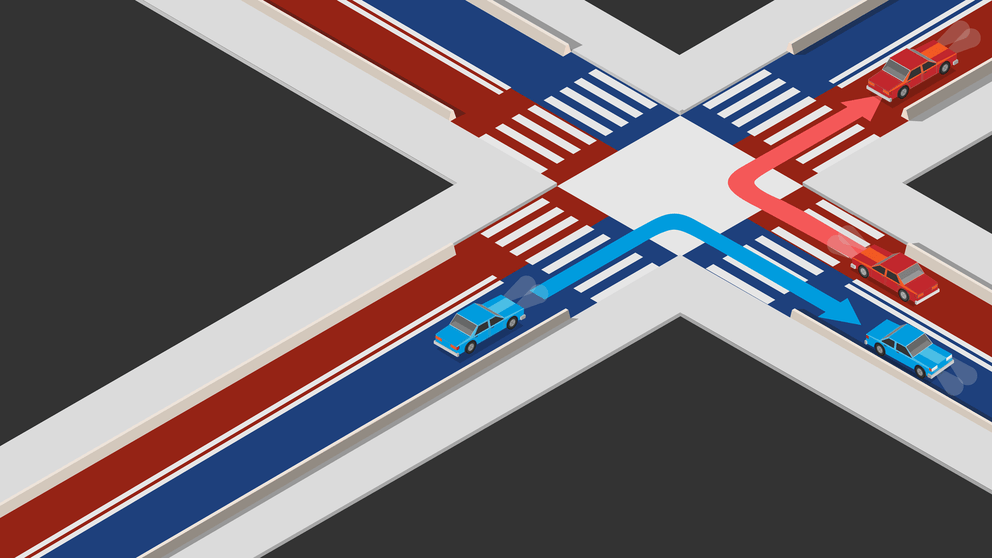Dec 7 2018
With a determination to find new ways to extend electronics beyond the use of silicon, physicists are testing other properties of electrons, beyond charge. In a research published on December 7th in the journal Science, a team led by Penn State professor of physics Jun Zhu illustrates a way to control electrons based on their energy in relation to momentum—called “valley degree of freedom.”
 Topological control of electrons (depicted as blue and red cars) in bilayer graphene. (Image credit: Seana Wood/Penn State MRI)
Topological control of electrons (depicted as blue and red cars) in bilayer graphene. (Image credit: Seana Wood/Penn State MRI)
“Imagine you are in a world where electrons are colored—red or blue,” Zhu said, “and the roads that electrons travel on are also colored red or blue. Electrons are only allowed to travel on roads of the same color, so that a blue electron would have to turn into a red electron to travel on the red road.”
Two years ago, Zhu’s team demonstrated that they could construct color-coded, two-way roads in a material known as bilayer graphene. As a result of their color-coding, these roads are topological. In the present study, the scientists made a four-way intersection where the color-coding of the roads is swapped to the other side. Thus, you have a situation where a blue car traveling northbound comes to this intersection and learns that on the other side of the intersection northbound roads are colored red. If the electron cannot change color, it is prohibited from traveling onward.
These roads are essentially electron waveguides formed by gates defined with extreme precision using advanced electron beam lithography. The colors are essentially the valley index of the cars, and the color-coding of the roads is regulated by the topology of the waveguides, similar to the right-driving and left-driving rules of different countries. Changing the color of the cars requires “inter-valley scattering,” which is reduced in the experiment to allow the traffic control to function.
What we have achieved here is a topological valley valve, which uses a new mechanism to control electron flow. This is part of a fledgling field of electronics called valleytronics. In our experiment, controlling the topology—the valley-momentum locking of the electrons—is what made it work.
Jun Zhu, Physics Professor, Penn State
In the research, the scientists asked where would the figurative blue car go if it could not travel onward?
“It will have to turn either left or right,” said lead author Jing Li, Zhu’s former doctoral student, currently a director’s postdoctoral fellow at Los Alamos National Lab.
“We have additional ways of controlling the turning traffic—by moving the lane incrementally closer to a right or left turn, the percentage of electrons/cars turning right or left can be smoothly tuned to be 60 percent one way, 40 percent the other, or any other combination of percentages.”
This controlled partition is known as a “beam splitter,” which is common for light but not easily realized with electrons. Zhu and Li said they are happy about this control they have accomplished for their color-coded roadways, as it enables more progressive experiments in the future.
“The creation of the device requires many steps and fairly complicated e-beam lithography,” Li said. “Thankfully, Penn State’s state-of-the-art nanofabrication facility as well as a team of professional support staff enabled us to do all this.”
The following challenge for Zhu’s team will be to try to construct their devices to work at room temperature rather than at the very cold temperatures they presently need. It is achievable, Zhu believes, but challenging.
The approach we took to make this device is scalable. If large-area bilayer graphene and hexagonal boron nitride become available, we can potentially make a city of topological roads and shuttle electrons to places they need to go, all without resistance. That would be very cool.
Jun Zhu, Physics Professor, Penn State
Besides lead author Li and corresponding author Zhu, other contributors to the Science paper, titled “A Valley Valve and Electron Beam Splitter,” are current and former graduate students Rui-Xing Zhang, Zhenxi Yin, Jianxiao Zhang, and Professor Chaoxing Liu, all of Penn State; and Kenji Watanabe and Takashi Taniguchi of the National Institute for Material Science, Tsukuba, Japan.
The National Science Foundation and the Office of Naval Research in the U.S. and the Elemental Strategy Initiative in Japan supported this research. Jun Zhu is a member of Penn State’s Center for Two-Dimensional and Layered Materials.
A Valley Valve and Electron Beam Splitter
A Valley Valve and Electron Beam Splitter - Jun Zhu, professor of physics, Penn State, explains her research that creates waveguides for electrons in 2D graphene material. (Credit: Seana Wood/Penn State MRI)